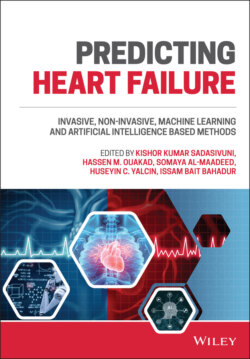Читать книгу Predicting Heart Failure - Группа авторов - Страница 31
1.5.2 Artificial Intelligence Supported HF Diagnostic Studies
ОглавлениеWith the use of artificial intelligence in health and especially in heart diseases, it has been possible to estimate the risk, diagnoses, and work flows and to apply sensitive treatment methods [21]. Thanks to artificial intelligence techniques, it has been possible to interpret large-sized data sets and thus obtain a more precise diagnosis. Within the artificial intelligence discipline, machine learning, image processing, robotics, and even natural language processing artificial intelligence techniques will be able to participate in the early detection and diagnosis of HF as well as outcome prediction and prognosis evaluation [22].
In a proposed study to help clinicians diagnose HF at an early stage, a scoring model based on a support vector machine (SVM) has been proposed. According to this model, samples were divided into three groups as healthy group, HF prone group, and HF group. The overall accuracy of the model in classification was 74.4% [23].
A study by Guidi et al. [24] was designed to help non-field experts make decisions in the analysis of HF. The system is based on three functional parts: diagnosis (severity assessment), prognosis, and follow-up. Four artificial intelligence techniques are used in the diagnostic function: artificial neural network (ANN), SVM, decision tree, and a fuzzy system with genetic algorithm support. A new technique for identifying HF patients using spectral analysis and neural networks was investigated in a study by Elfadil et al. [25]. A data set was used in the study, with 17 of the 53 samples being normal and the rest being patients. HF patients were divided into four groups with an accuracy of 83.65%.
Gharehchopogh et al. [26] presented a decision support model to help physicians in the study. The model, based on an ANN, was able to detect the presence or absence of HF with 85% accuracy. The study is within the scope of medical data mining.
Candelieri et al. developed a decision tree to determine patient stabilization [27] (with 88% accuracy). Pecchia et al. used decision tree techniques to classify patients into three severity groups using heart rate variability (HRV) measurements (HF: Healthy = 96% accuracy; Severe–Moderate = 79.3% accuracy) [28].
